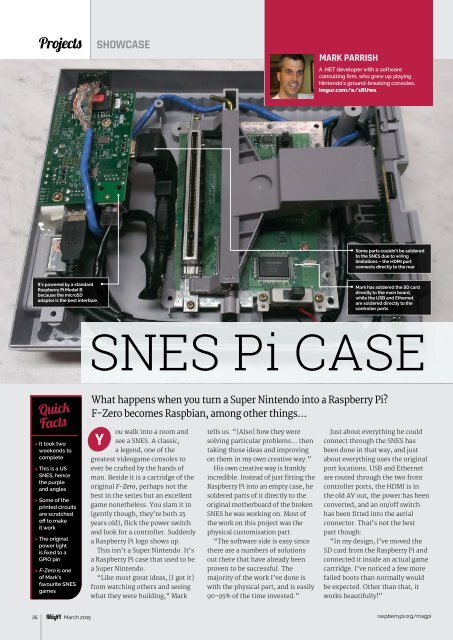Create successful ePaper yourself
Turn your PDF publications into a flip-book with our unique Google optimized e-Paper software.
Projects<br />
SHOWCASE<br />
MARK PARRISH<br />
A .NET developer with a software<br />
consulting firm, who grew up playing<br />
Nintendo’s ground-breaking consoles.<br />
imgur.com/a/1RUwa<br />
Some parts couldn’t be soldered<br />
to the SNES due to wiring<br />
limitations – the HDMI port<br />
connects directly to the rear<br />
It’s powered by a standard<br />
Raspberry Pi Model B<br />
because the microSD<br />
adaptor is the best interface<br />
Mark has soldered the SD card<br />
directly to the main board,<br />
while the USB and Ethernet<br />
are soldered directly to the<br />
controller ports<br />
SNES Pi CASE<br />
Quick<br />
Facts<br />
> It took two<br />
weekends to<br />
complete<br />
> This is a US<br />
SNES, hence<br />
the purple<br />
and angles<br />
> Some of the<br />
printed circuits<br />
are scratched<br />
off to make<br />
it work<br />
> The original<br />
power light<br />
is fixed to a<br />
GPIO pin<br />
> F-Zero is one<br />
of Mark’s<br />
favourite SNES<br />
games<br />
What happens when you turn a Super Nintendo into a Raspberry Pi?<br />
F-Zero becomes Raspbian, among other things…<br />
Y<br />
ou walk into a room and<br />
see a SNES. A classic,<br />
a legend, one of the<br />
greatest videogame consoles to<br />
ever be crafted by the hands of<br />
man. Beside it is a cartridge of the<br />
original F-Zero, perhaps not the<br />
best in the series but an excellent<br />
game nonetheless. You slam it in<br />
(gently though, they’re both 25<br />
years old), flick the power switch<br />
and look for a controller. Suddenly<br />
a Raspberry Pi logo shows up.<br />
This isn’t a Super Nintendo. It’s<br />
a Raspberry Pi case that used to be<br />
a Super Nintendo.<br />
“Like most great ideas, [I got it]<br />
from watching others and seeing<br />
what they were building,” Mark<br />
tells us. “[Also] how they were<br />
solving particular problems… then<br />
taking those ideas and improving<br />
on them in my own creative way.”<br />
His own creative way is frankly<br />
incredible. Instead of just fitting the<br />
Raspberry Pi into an empty case, he<br />
soldered parts of it directly to the<br />
original motherboard of the broken<br />
SNES he was working on. Most of<br />
the work on this project was the<br />
physical customisation part.<br />
“The software side is easy since<br />
there are a numbers of solutions<br />
out there that have already been<br />
proven to be successful. The<br />
majority of the work I’ve done is<br />
with the physical part, and is easily<br />
90-95% of the time invested.”<br />
Just about everything he could<br />
connect through the SNES has<br />
been done in that way, and just<br />
about everything uses the original<br />
port locations. USB and Ethernet<br />
are routed through the two front<br />
controller ports, the HDMI is in<br />
the old AV out, the power has been<br />
converted, and an on/off switch<br />
has been fitted into the aerial<br />
connector. That’s not the best<br />
part though:<br />
“In my design, I’ve moved the<br />
SD card from the Raspberry Pi and<br />
connected it inside an actual game<br />
cartridge. I’ve noticed a few more<br />
failed boots than normally would<br />
be expected. Other than that, it<br />
works beautifully!”<br />
26 March 2015<br />
raspberrypi.org/magpi


